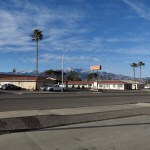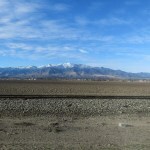Round the Mountain
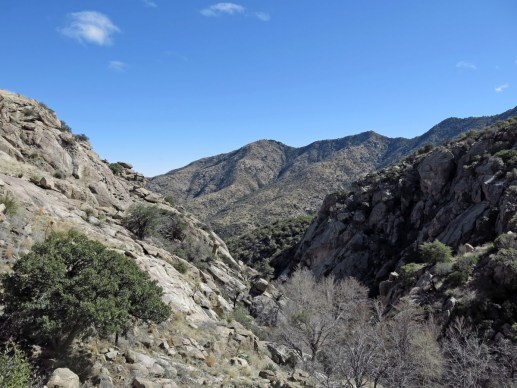
Today’s mission involved a trail I’d been wanting to try for more than a year. It traverses the east slope of one of my favorite ranges across the border in Arizona, at mid-elevations so that I expected it to be snow-free in winter. It begins in the big southeastern canyon at just over 6,000 feet and tops out on the northern crest at 8,700 feet, but in crossing a half dozen intervening ridges and canyons, it climbs up and down as much as a thousand feet per canyon, so an out-and-back hike can accumulate some decent total elevation gain.
The full one-way distance is more than fifteen miles; I was hoping to get about halfway and back in a day hike. But the drive is a little over two hours and I couldn’t avoid getting a late start – it took me fifteen minutes to get the hard frost off my windshield at home.
I drove west under a cloudy sky, but it was beginning to clear as I drove up the canyon to the trailhead.
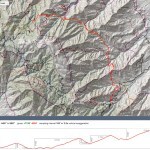
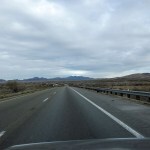
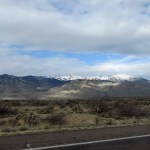
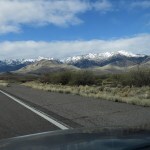
The southeastern trailhead is on the highway up the canyon, but the map showed that I could avoid the first intervening ridge and thus get farther into the backcountry by taking a short cut from a lower picnic area. I found an older man parked there in a pickup with camper shell; he preceded me up the trail dressed in colorful old-school flannel – making me feel like a real yuppie in my high-tech fleece. I soon passed him, and he remarked on how cold it was.
But this first segment of trail, climbing to the first ridgetop, unfolded at an average 15 percent grade, so I quickly shed layers. Sunlight glinted off the snowy crest thousands of feet above, while the thawing dirt of the trail had been deeply chewed up by horses as well as hikers’ boots. Thankfully it was sand and gravel and didn’t stick to my boots like the clay mud farther north. And I was admiring the surrounding igneous boulders and outcrops, which reminded me of my beloved desert.
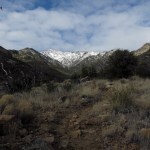
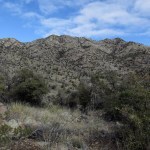
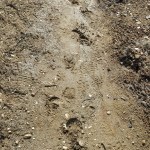
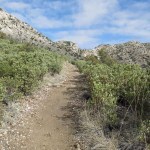
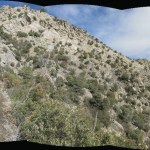
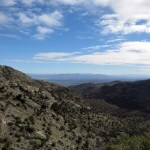
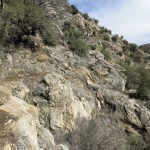
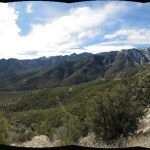
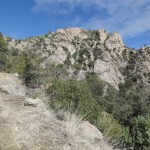
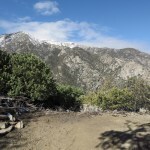
That first climb was about 1,300 feet, and ended at a knife-edge saddle overlooking a completely new watershed. The tallest peaks of the range glittered above, and I could hear a creek roaring a thousand feet below. Far to the north I could see a prominent bare-rock peak rising from the distant ridge I hoped to reach. From here, it looked much too far – especially since at the end of the day I’d have to climb back up out of this canyon.
The upper part of the descending trail was frozen solid under a thin layer of snow, and was steep enough that I had to go slow to keep from slipping. This trail was literally clinging to the wall of the canyon, with overhangs in some spots. Eventually I reached switchbacks that were mostly in sun, but there were so many I soon lost count. It seemed to take forever to reach the creek.
Brush had been cut recently all along this trail, and cut branches had often been left blocking the trail. The canyon was impressively rocky; the bottom was lined with sycamores; I easily found stepping stones to cross on.
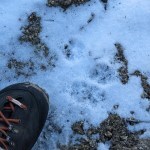
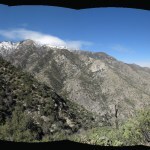
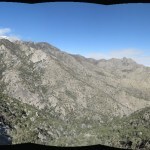
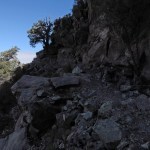
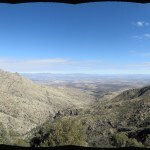
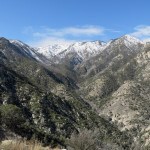
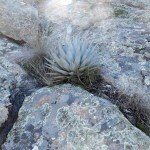
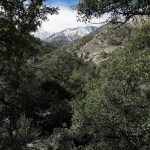
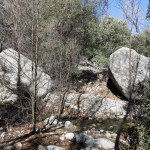
Although the slopes on the opposite side of the canyon were gentler, they were also rockier, with big exposed slabs of igneous rock. After crossing a much smaller side canyon, I reached a bigger side canyon bearing a creek as big as the first, lined with solid rock. I began noticing metasedimentary rock with deformed strata just like the rock on my desert land. This is what I love – much rockier than the landscape around my New Mexico home.
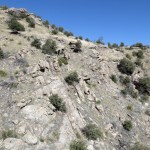
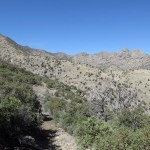
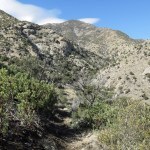
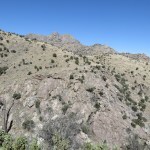
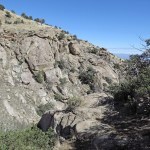
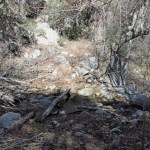
Past that canyon, the trail climbed over a low divide where I reached a junction with an ascending ridge trail, now abandoned, then down into a hollow where I met the lower end of the abandoned trail. The recent trail work ended here.
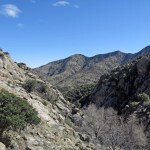
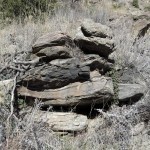
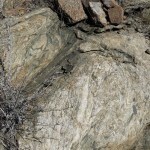
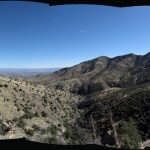
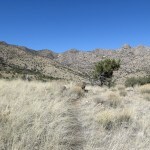
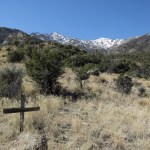
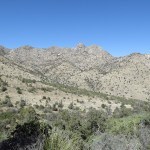
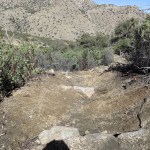
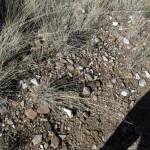
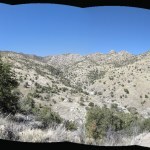
Past that junction, all human tracks ended and the trail was either blocked by shrubs or overgrown with tall grasses. But I was able to keep going by reading the landscape.
I made it another two-thirds of a mile before running out of time. My planned destination was another mile and a half farther and 1,200 feet higher. With an earlier start, I might’ve made it.
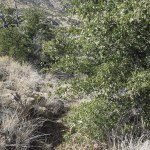
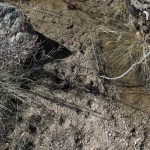
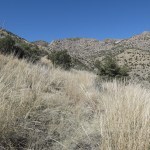
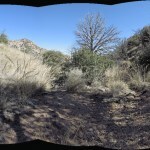
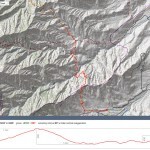
But I wasn’t disappointed; this route had turned out even better than expected. Sure, it’s a challenge climbing over those intervening ridges, but this turned out to be the most spectacular landscape in our region, and I look forward to returning in better shape, and with more time.
I flushed a white-tailed buck out of the second canyon, and a dove out of the brush along the trail, but I was surprised not to see any hawks or eagles.
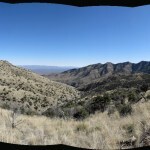
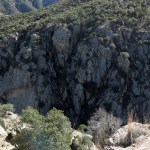
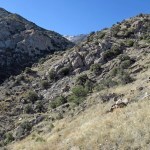
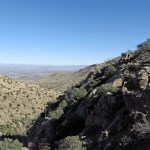
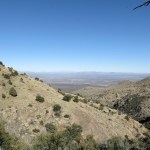
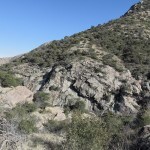
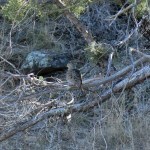
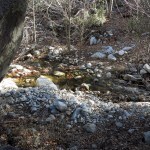
I took my time climbing out of that first deep canyon. It did take about an hour, but the frozen part was easier going up than going down.
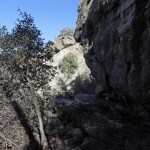
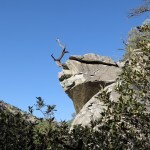
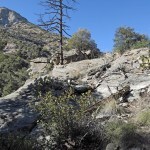
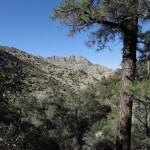
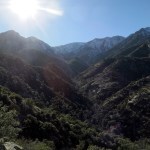
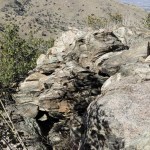
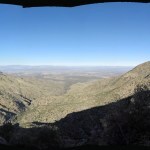
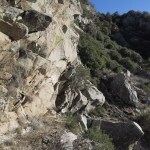
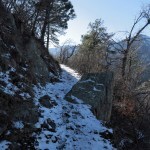
The final descent to the trailhead was mostly in shade. I discovered someone had come partway up on horseback while I was over in the backcountry, so the trail was even more chewed up than in the morning.
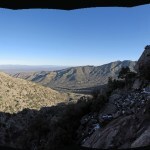
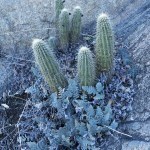
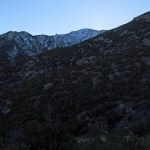
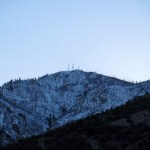
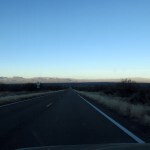
Another night in a motel, followed by a lonely drive home through a wild landscape.
